-
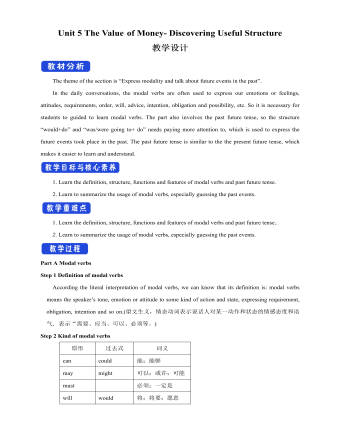
新人教版高中英语必修3Unit 5 The Value of Money- Discovering Useful Structure教学设计
Step 3 Meaning1. 过去将来时表示从过去某一时间来看将要发生的动作或存在的状态, 常用在宾语从句中。一般由“would/should +动词原形”构成。She hoped that they would meet again someday. 她希望将来有一天他们能再见面。2. was/were going to+动词原形: 表示过去将要发生或很有可能发生的动作, 常用于口语中, 表示预言、意图或者打算等。He was going to start work the following week. 他打算下星期开始工作。3. was/were about to do: 常用来表示即将发生的动作, “刚要/正要做……”。注意该结构不与任何时间状语连用。I felt that something terrible was about to happen. 我感到某种可怕的事情即将发生。4.was/were to do: 表示“曾计划做某事”, 如果表示“本来计划做某事, 动作没实现”, 则需用 “was/were to have done”。She said she was to have told me about the accident. 她说她本来想告诉我关于事故的事。5.Start, go, come, leave, see, meet等动词的过去进行时: 表示就过去某一时刻而言即将发生的动作。She was coming later. 她随后就来。I had just put on my overcoat and was leaving to visit a friend of mine. 我刚穿上外套要去看我的一个朋友。
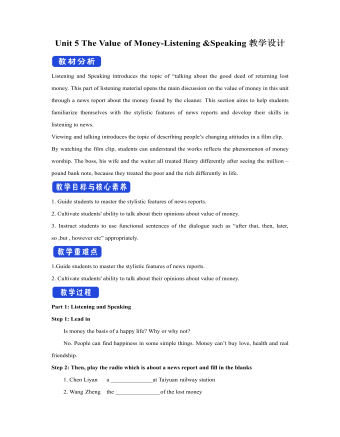
新人教版高中英语必修3Unit 5 The Value of Money-Listening &Speaking教学设计
Step 4: Listen again and decide if the following statements are true (T) or false (F).1 It was the first time Chen Liyan's story was reported. T口 F口2 Chen found 10,000 yuan in a small plastic bag in Taiyuan railway station口 F口3 Wang Zheng apologized to Chen because he couldn't offer her more money. T口 F口4 Chen took out a large loan to cure her daughter, T口 F口5 Wang set up a fundraising website for Chen's daughter after Chen told him about her situation. T口 F口Step 5:After listening, discuss the questions.1 What kind of person do you think Chen Liyan is?Chen Liyan is generous and honest because she returned a large sum of money to the owner.2 Did Chen return the money because she didn't need it?No. She returned the money because it was the right thing to do. Evidence for this is that she refused to accept the reward money because she felt that it had not been earned. 3 Is it common for people to do what Chen did?It depends on the culture. In some countries it is quite common to return money that has been found. In other countries, people believe "Finders are keepers!" 4 How did Wang Zheng feel about the return of his money?He must have been very happy and relieved to have gotten his money back. We know this because he thanked Chen repeatedly and even offered her a reward.5 Why did Ma Dongbao tell Wang about Chen's family?He must have had great sympathy for Chen and her daughter and wanted to help them.'We know this because he arranged help for them. 6 How did the news reporter feel about Chen's actions?The news reporter felt that it showed that money wasn't the most important thing in life. We know this because the reporter told us that this is what Chen believes. and then said, “that's a great attitude to take."
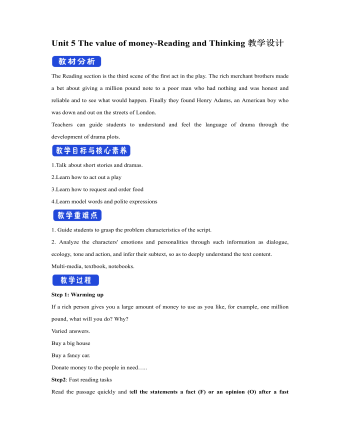
新人教版高中英语必修3Unit 5 The value of money-Reading and Thinking教学设计二
? Could you offer me some kind of work here?? I don’t want your charity, I just want an honest job.? Careless: I landed in Britain by accident.Step 7:Consolidation.? Find Henry? Roderick and Oliver were I .making a bet when they saw Henry, a poor young man. ? Know Henry? About a month ago, Henry was sailing and later he found himself carried out to sea by a strong wind. Fortunately, he 2.was spotted by a ship. And it was the ship that brought him to 3.England? Offer money to Henry ? Oliver and Roderick gave Henry a letter and told him that there was money in it. They 4.persuaded him to accept it, and made him 5.promise that it wouldn't be opened until 2 o'clock.Step 8:Language pointsa large amount of: a large quantity of; a great deal ofe.g. They bought a large amount of furniture before they moved their new house.make a bet: make an arrangement to risk money, etc. on an event of which the result is doubtful.e.g. We made a bet on the result of the match.permit sb to do something: allow somebody to do somethinge.g. My mother doesn’t permit me to ride in the street after it rained.by accident: as a result of chancee.g. I only found it by accident.stare at: look at somebody or something with the eyes wide open in a fixed gaze( in astonishment, wonder, fear, etc)to be honest: to tell you the truth; to be franke.g. To be honest, I don’t think we have a chance of winning.Step7 Homework:What do you think will happen to Henry? Will the bank-note help him or get him into trouble?
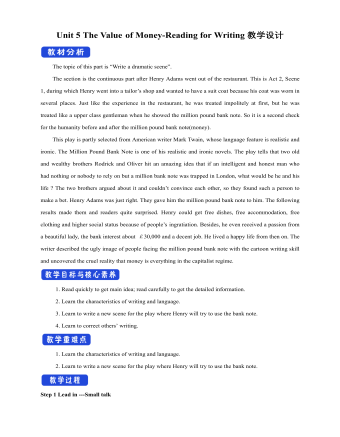
新人教版高中英语必修3Unit 5 The Value of Money-Reading for Writing教学设计二
2. 您能看到, 我头发太长了。You can see that my hair is much too long.3. 无论什么时候, 只要您想回来就回来。Please come back whenever you want.4. 您仅有很少的头发要理! You only have too little hair to cut !5. 为您服务是我的荣幸!It is my honour to serve you!Step 9 Writing(Henry is walking down the street when he sees a sign for a place that cuts hair. He decides to have it cut. )H=Henry B=BarberH: Good afternoon, I’d like to have my hair cut, if I may. (The barber looks at Henry’s hair and continues cutting another man’s hair. ) Er, I’d really like a haircut. As you can see it’s much too long. B: (in a rude manner) Yes, I can see that. Indeed, I can. H: Fine, well, I’ll have a seat then. (He sits in one of the barber’s chairs. The barber turns to look at Henry. )B: It’s quite expensive here, you know! Are you sure you can afford it?H: Yes. I think so. (After his hair is cut, the barber tells Henry how much he must pay. Henry shows the barber the bank note. )B: Why Mr. . . (looks shocked)H: Adams. Henry Adams. I’m sorry. I don’t have any change. B: Please don’t worry! (wearing a big smile) Nothing to worry about! Nothing at all! Please come back whenever you want, even if you only have too little hair to cut! It will be my honour to serve you!Step 10 Pair workExchange drafts with a partner. Use this checklist to help your partner revise his/her draft.1. Are all the elements of a play included and in good order ?2. Do the character use suitable language ?3. Are the stage directions clear and useful ?4. Is the plot clear and exciting enough ?
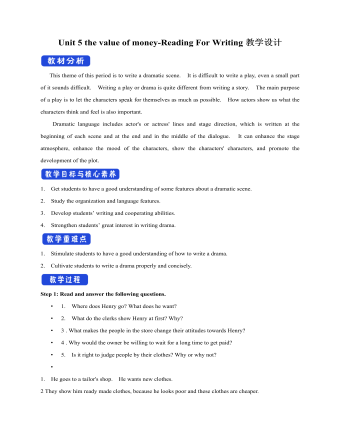
新人教版高中英语必修3Unit 5 the value of money-Reading For Writing教学设计一
【参考范文】Narrator:(Henry is smiling as he leaves the restaurant. As he is walking down the street, he sees a sign for a place that cuts hair. He decides to get it cut. )H=Henry;B=Barber;R=rude manH:Good afternoon, I'd like to get a cut, if I may. (The barber looks at Henry's hair and continues cutting another man's hair. )Er, I'd really like a haircut. As you can see it's much too long. B:(in a rude manner) Yes, I can see that. Indeed, I can. H:Fine, well I'll have a seat then. (He sits in one of the barber's chairs. The barber turns to look at Henry. )B:It's quite expensive here, you know!Are you sure you can afford it?H:Yes. I think so. (In comes the rude man. )R:Hey you there. I need a haircut quickly. Can you do me straightaway?B:All right, then, get in the chair and I'll see what I can do. R:Thank you. (sits down in one of the barber's chairs)H:Excuse me, but I was here first. Aren't you going to do my hair first?B:This man's in a hurry. H:Well so am I!I insist that you cut my hair first. B:OK, but I'll have to be quick. This gentleman is waiting. H:Thank you. (They both become quiet. After his hair is cut, the barber tells Henry how much he must pay. Henry shows the barber the bank note. )B:Why, Mr . . . (looks shocked)H:Adams. Henry Adams. I'm sorry, I don't have any change. R:You're that Mr Adams! Well,I'm glad I waited or I might never have known it was you. B:Why, Mr Adams, please don't worry!(wearing a big smile) Nothing to worry about!Nothing at all!Please come back any time, even if you only need too little hairs cut!It will be my honour to serve you!
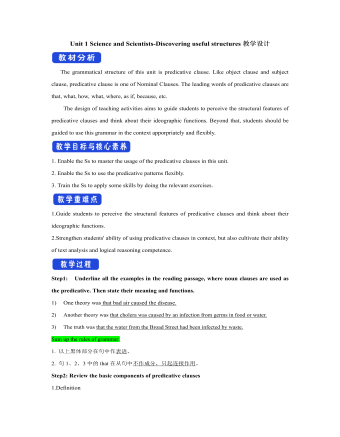
新人教版高中英语选修2Unit 1 Science and Scientists-Discovering useful structures教学设计
The grammatical structure of this unit is predicative clause. Like object clause and subject clause, predicative clause is one of Nominal Clauses. The leading words of predicative clauses are that, what, how, what, where, as if, because, etc.The design of teaching activities aims to guide students to perceive the structural features of predicative clauses and think about their ideographic functions. Beyond that, students should be guided to use this grammar in the context apporpriately and flexibly.1. Enable the Ss to master the usage of the predicative clauses in this unit.2. Enable the Ss to use the predicative patterns flexibly.3. Train the Ss to apply some skills by doing the relevant exercises.1.Guide students to perceive the structural features of predicative clauses and think about their ideographic functions.2.Strengthen students' ability of using predicative clauses in context, but also cultivate their ability of text analysis and logical reasoning competence.Step1: Underline all the examples in the reading passage, where noun clauses are used as the predicative. Then state their meaning and functions.1) One theory was that bad air caused the disease.2) Another theory was that cholera was caused by an infection from germs in food or water.3) The truth was that the water from the Broad Street had been infected by waste.Sum up the rules of grammar:1. 以上黑体部分在句中作表语。2. 句1、2、3中的that在从句中不作成分,只起连接作用。 Step2: Review the basic components of predicative clauses1.Definition
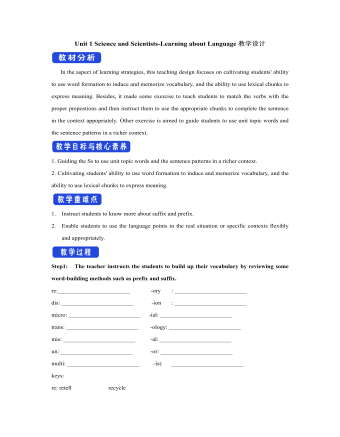
新人教版高中英语选修2Unit 1 Science and Scientists-Learning about Language教学设计
Step 7: complete the discourse according to the grammar rules.Cholera used to be one of the most 1.__________ (fear) diseases in the world. In the early 19th century, _2_________ an outbreak of cholera hit Europe, millions of people died. But neither its cause, 3__________ its cure was understood. A British doctor, John Snow, wanted to solve the problem and he knew that cholera would not be controlled _4_________ its cause was found. In general, there were two contradictory theories 5 __________ explained how cholera spread. The first suggested that bad air caused the disease. The second was that cholera was caused by an _6_________(infect) from germs in food or water. John Snow thought that the second theory was correct but he needed proof. So when another outbreak of cholera hit London in 1854, he began to investigate. Later, with all the evidence he _7_________ (gather), John Snow was able to announce that the pump water carried cholera germs. Therefore, he had the handle of the pump _8_________ (remove) so that it couldn't be used. Through his intervention,the disease was stopped in its tracks. What is more, John Snow found that some companies sold water from the River Thames that __9__________________ (pollute) by raw waste. The people who drank this water were much more likely _10_________ (get) cholera than those who drank pure or boiled water. Through John Snow's efforts, the _11_________ (threaten) of cholera around the world saw a substantial increase. Keys: 1.feared 2.when 3. nor 4.unless 5.that/which 6.infection 7.had gathered 8.removed 9.was polluted 10.to get 11. threat
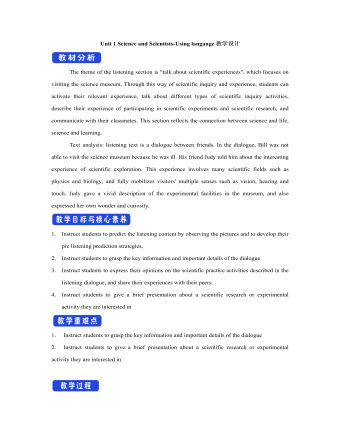
新人教版高中英语选修2Unit 1 Science and Scientists-Using langauge教学设计
This happens because the dish soap molecules have a strong negative charge, and the milk molecules have a strong positive charge. Like magnets, these molecules are attracted to each other, and so they appear to move around on the plate, taking the food coloring with them, making it look like the colors are quickly moving to escape from the soap.Listening text:? Judy: Oh, I'm so sorry that you were ill and couldn't come with us on our field trip. How are you feeling now? Better?? Bill: Much better, thanks. But how was it?? Judy: Wonderful! I especially liked an area of the museum called Light Games.it was really cool. They had a hall of mirrors where I could see myself reflected thousands of times!? Bill: A hall of mirrors can be a lot of fun. What else did they have?? Judy: Well, they had an experiment where we looked at a blue screen for a while, and then suddenly we could see tiny bright lights moving around on it. You'll never guess what those bright lights were!? Bill: Come on, tell me!? Judy: They were our own blood cells. For some reason, our eyes play tricks on us when we look at a blue screen, and we can see our own blood cells moving around like little lights! But there was another thing I liked better. I stood in front of a white light, and it cast different shadows of me in every color of the rainbow!? Bill: Oh, I wish I had been there. Tell me more!? Judy: Well, they had another area for sound. They had a giant piano keyboard that you could use your feet to play. But then, instead of playing the sounds of a piano, it played the voices of classical singers! Then they had a giant dish, and when you spoke into it, it reflected the sound back and made it louder. You could use it to speak in a whisper to someone 17 meters away.? Bill: It all sounds so cool. I wish I could have gone with you? Judy: I know, but we can go together this weekend. I'd love to go there again!? Bill: That sounds like a great idea!
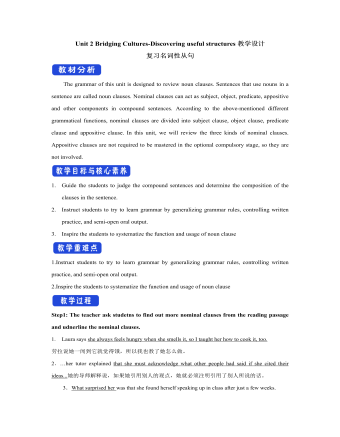
新人教版高中英语选修2Unit 2 Bridging Cultures-Discovering useful structures教学设计
The grammar of this unit is designed to review noun clauses. Sentences that use nouns in a sentence are called noun clauses. Nominal clauses can act as subject, object, predicate, appositive and other components in compound sentences. According to the above-mentioned different grammatical functions, nominal clauses are divided into subject clause, object clause, predicate clause and appositive clause. In this unit, we will review the three kinds of nominal clauses. Appositive clauses are not required to be mastered in the optional compulsory stage, so they are not involved.1. Guide the students to judge the compound sentences and determine the composition of the clauses in the sentence.2. Instruct students to try to learn grammar by generalizing grammar rules, controlling written practice, and semi-open oral output.3. Inspire the students to systematize the function and usage of noun clause1.Instruct students to try to learn grammar by generalizing grammar rules, controlling written practice, and semi-open oral output.2.Inspire the students to systematize the function and usage of noun clauseStep1: The teacher ask studetns to find out more nominal clauses from the reading passage and udnerline the nominal clauses.
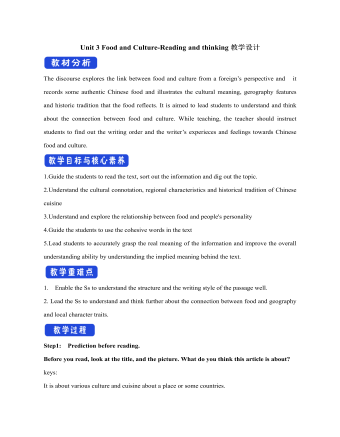
新人教版高中英语选修2Unit 3 Food and Culture-Reading and thinking教学设计
The discourse explores the link between food and culture from a foreign’s perspective and it records some authentic Chinese food and illustrates the cultural meaning, gerography features and historic tradition that the food reflects. It is aimed to lead students to understand and think about the connection between food and culture. While teaching, the teacher should instruct students to find out the writing order and the writer’s experieces and feelings towards Chinese food and culture.1.Guide the students to read the text, sort out the information and dig out the topic.2.Understand the cultural connotation, regional characteristics and historical tradition of Chinese cuisine3.Understand and explore the relationship between food and people's personality4.Guide the students to use the cohesive words in the text5.Lead students to accurately grasp the real meaning of the information and improve the overall understanding ability by understanding the implied meaning behind the text.1. Enable the Ss to understand the structure and the writing style of the passage well.2. Lead the Ss to understand and think further about the connection between food and geography and local character traits.Step1: Prediction before reading. Before you read, look at the title, and the picture. What do you think this article is about?keys:It is about various culture and cuisine about a place or some countries.
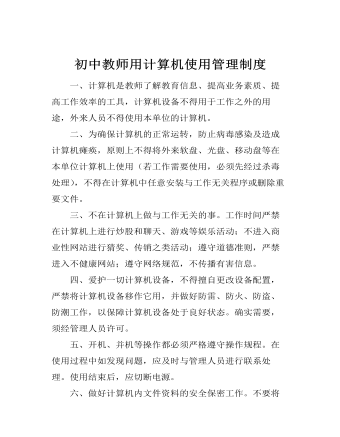
初中教师用计算机使用管理制度
二、为确保计算机的正常运转,防止病毒感染及造成计算机瘫痪,原则上不得将外来软盘、光盘、移动盘等在本单位计算机上使用(若工作需要使用,必须先经过杀毒处理),不得在计算机中任意安装与工作无关程序或删除重要文件。 三、不在计算机上做与工作无关的事。工作时间严禁在计算机上进行炒股和聊天、游戏等娱乐活动;不进入商业性网站进行猜奖、传销之类活动;遵守道德准则,严禁进入不健康网站;遵守网络规范,不传播有害信息。 四、爱护一切计算机设备,不得擅自更改设备配置,严禁将计算机设备移作它用,并做好防雷、防火、防盗、防潮工作,以保障计算机设备处于良好状态。确实需要,须经管理人员许可。
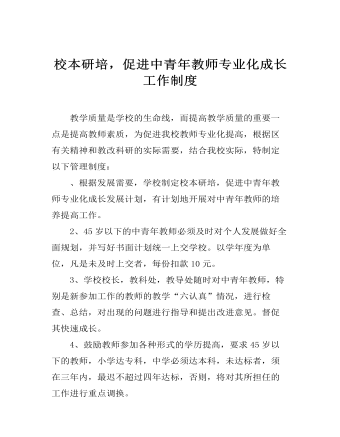
校本研培,促进中青年教师专业化成长工作制度
根据发展需要,学校制定校本研培,促进中青年教师专业化成长发展计划,有计划地开展对中青年教师的培养提高工作。 2、45岁以下的中青年教师必须及时对个人发展做好全面规划,并写好书面计划统一上交学校。以学年度为单位,凡是未及时上交者,每份扣款10元。 3、学校校长,教科处,教导处随时对中青年教师,特别是新参加工作的教师的教学“六认真”情况,进行检查、总结,对出现的问题进行指导和提出改进意见。督促其快速成长。 4、鼓励教师参加各种形式的学历提高,要求45岁以下的教师,小学达专科,中学必须达本科,未达标者,须在三年内,最迟不超过四年达标,否则,将对其所担任的工作进行重点调换。 5、在职参加学历学习达标者,学校给予200元的补助奖励。
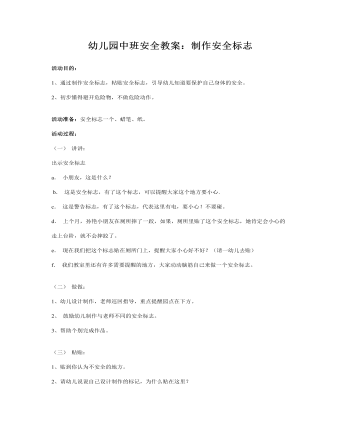
幼儿园中班安全教案:制作安全标志
活动准备:安全标志一个、蜡笔、纸。 活动过程:(一)讲讲: 出示安全标志 a.小朋友,这是什么? b.这是安全标志,有了这个标志,可以提醒大家这个地方要小心. c.这是警告标志,有了这个标志,代表这里有电,要小心!不要碰。 d.上个月,孙艳小朋友在厕所摔了一跤,如果,厕所里贴了这个安全标志,她肯定会小心的走上台阶,就不会摔跤了。
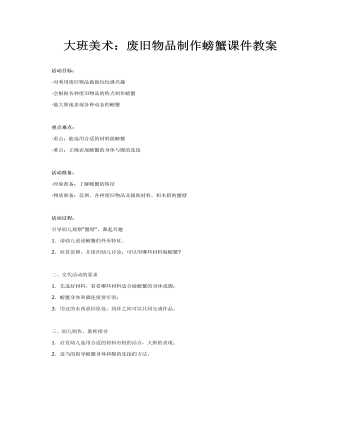
大班美术:废旧物品制作螃蟹课件教案
重点难点:·重点:能选用合适的材料做螃蟹·难点:正确表现螃蟹的身体与脚的连接 活动准备:·经验准备:了解螃蟹的特征·物质准备:范例、各种废旧物品及辅助材料,积木搭的蟹塘 活动过程:引导幼儿观察“蟹塘”,激起兴趣1.请幼儿说说螃蟹的外形特征。2.欣赏范例,并组织幼儿讨论:可以用哪些材料做螃蟹? 二、交代活动的要求1.先选好材料,看看哪些材料适合做螃蟹的身体或脚;2.螃蟹身体和脚连接要牢固;3.用过的东西放回原处,同伴之间可以共同完成作品。 三、幼儿制作,教师指导1.启发幼儿选用合适的材料有机的结合,大胆的表现。2.适当的指导螃蟹身体和脚的连接的方法。 四、作品讲评1.请幼儿把作品放在“蟹塘”,相互欣赏,并互介绍自己的材料。2.请幼儿说说谁的螃蟹做的最好,用的材料最巧妙? 延伸活动:将剩余的材料放在美工区供幼儿平时制作。并经常添置,制作其他手工品。
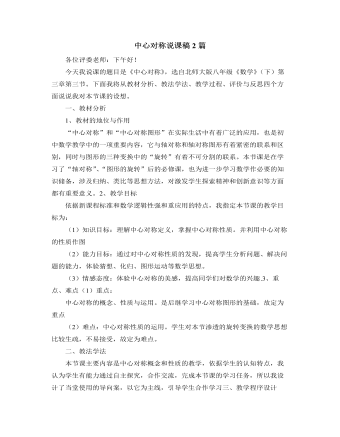
北师大版初中数学八年级下册中心对称说课稿2篇
学生在观察和讨论后,由师生合作,归纳出中心对称的性质:(1)关于中心对称的两个图形,对称点所连线段都经过对称中心,而且被对称中心所平分;(2)关于中心对称的两个图形是全等图形.让学生尝试自己证明△ABC与△A′B′C′全等,然后在教师的引导下相互交流。接着,对“轴对称”和“中心对称”的概念进行比较,我采用列表格的方式,从三个方面分别让学生去填,意图让学生把新学的知识及时纳入到已学的知识体系中去。4、灵活运用体会内涵1)首先讲授例1。(1)选择点O为对称中心,画出点A关于点O的对称点A′;(2)选择点O为对称中心,画出线段AB关于点O的对称线段A′B′.(3)已知四边形ABCD和O点,画出四边形ABCD关于O点的对称图形。在老师的引导下,共同完成作图,并规范画图方法:要画一个多边形关于已知点的对称图形,只要画出这个多边形的各个顶点关于已知点的对称点,再顺次连接各点即可。在本次活动中,意图利用中心对称的性质进行作图,加强对中心对称性质的理解。
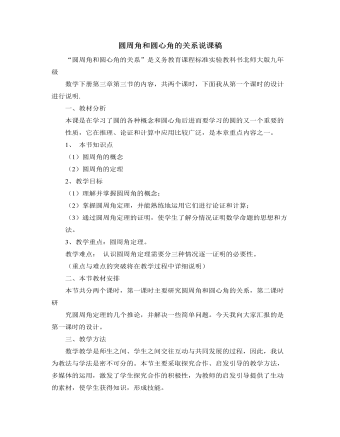
北师大版初中数学九年级下册圆周角和圆心角的关系说课稿
(设计意图:因为圆中有关的点、线、角及其他图形位置关系的复杂,学生往往因对已知条件的分析不够全面,忽视某个条件,某种特殊情况,导致漏解。采用小组讨论交流的方式进行要及时进行小组评价。)(3) 议一议( 如图,OA、OB、OC都是圆O的半径∠AOB=2∠BOC, 求证:∠ACB=2∠BAC。)(设计意图:通过练习,使学生能灵活运用圆周角定理进行几何题的证明,规范步骤,提高利用定理解决问题的能力。)(三)说小结首先,通过学生小组交流,谈一谈你有什么收获。(提示学生从三方面入手:1、学到了知识;2、掌握了哪些数学方法;3、体会到了哪些数学思想。)然后,教师引导小组间评价。使学生对本节内容有一个更系统、深刻的认识,实现从感性认识到理性认识的飞跃。(四)、板书设计为了集中浓缩和概括本课的教学内容,使教学重点醒目、突出、合理有序,以便学生对本课知识点有了完整清晰的印象。我只选择了本节课的两个知识点作为板书。
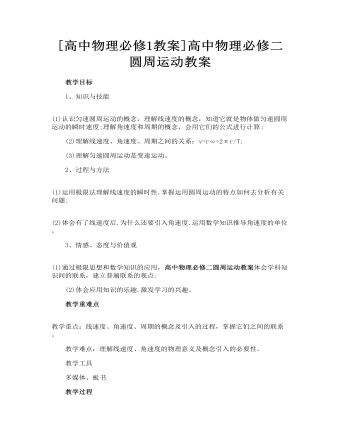
高中物理必修二圆周运动教案
1、知识与技能 (1)认识匀速圆周运动的概念,理解线速度的概念,知道它就是物体做匀速圆周运动的瞬时速度;理解角速度和周期的概念,会用它们的公式进行计算; (2)理解线速度、角速度、周期之间的关系:v=rω=2πr/T; (3)理解匀速圆周运动是变速运动。 2、过程与方法 (1)运用极限法理解线速度的瞬时性.掌握运用圆周运动的特点如何去分析有关问题; (2)体会有了线速度后.为什么还要引入角速度.运用数学知识推导角速度的单位。
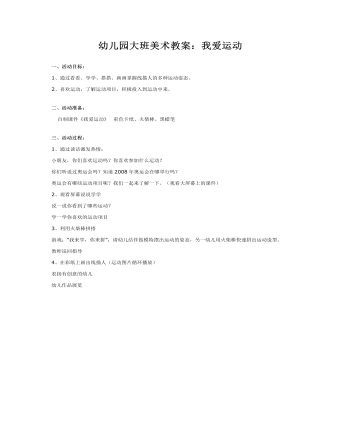
幼儿园大班美术教案:我爱运动
二、活动准备: 自制课件《我爱运动》 彩色卡纸、火柴棒、黑蜡笔三、活动过程: 1、通过谈话激发热情: 小朋友,你们喜欢运动吗?你喜欢参加什么运动? 你们听说过奥运会吗?知道2008年奥运会在哪举行吗? 奥运会有哪些运动项目呢?我们一起来了解一下。(观看大屏幕上的课件) 2、观看屏幕说说学学
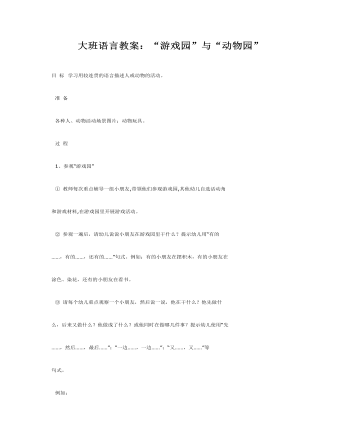
大班语言教案:“游戏园”与“动物园”
准备 各种人、动物活动场景图片;动物玩具。 过程 1、参观“游戏园” ①教师每次重点辅导一组小朋友,带领他们参观游戏园,其他幼儿自选活动角和游戏材料,在游戏园里开展游戏活动。 ②参观一遍后,请幼儿说说小朋友在游戏园里干什么?提示幼儿用“有的……,有的……,还有的……”句式。例如:有的小朋友在摆积木,有的小朋友在涂色、染花,还有的小朋友在看书。 ③请每个幼儿重点观察一个小朋友,然后说一说,他在干什么?他先做什么,后来又做什么?他做成了什么?或他同时在做哪几件事?提示幼儿使用“先……,然后……,最后……”;“一边……,一边……”;“又……,又……”等句式。 例如: “他在搭火车站,他先搭大楼(候车室),然后搭铁路和桥,最后建广场,他搭成了一个新火车站。”
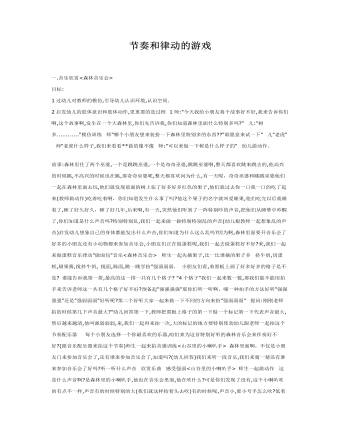
大班游戏教案:节奏和律动的游戏
2启发幼儿的肢体意识和肢体动作,更重要的是过程 1师:"今天我给小朋友将个故事好不好,我来告诉你们啊,这个故事啊,发生在一个大森林里,你们先告诉我,你们知道森林里面什么特别多吗?" 儿:"树多............"模仿训练 师"哪个小朋友想来装扮一下森林里特别多的东西??"谁愿意来试一下" 儿"老虎" 师"老虎什么样子,我们来看看**做的像不像 师:"可以来做一下树是什么样子的" 幼儿做动作。故事:森林里住了两个巫婆,一个是跳跳巫婆,一个是奇奇巫婆,跳跳巫婆啊,整天都喜欢跳来跳去的,他高兴的时候跳,不高兴的时候也在跳,那奇奇巫婆呢,整天都喜欢问为什么,有一天呢,奇奇巫婆和跳跳巫婆他们一起在森林里面去玩,他们就发现前面的树上张了好多好多红色的果子,他们就过去你一口我一口的吃了起来(教师做动作)吃着吃着啊,你们知道发生什么事了吗?他这个果子的名字就叫爱睡果,他们吃完以后就睡着了,睡了好久好久,睡了好几年,后来啊,有一天,突然他们听到了一阵特别吵的声音,把他们从睡梦中吵醒了,你们知道是什么声音吗?特别特别乱,我们一起来做一做特别特别乱的声音(幼儿根教师一起想象乱的声音)启发幼儿想象自己的身体都能发出什么声音,你们知道为什么这么乱吗?因为啊,森林里面要开音乐会了好多的小朋友还有小动物都来参加音乐会,小朋友们正在做蛋糕呢,我们一起去做蛋糕好不好?来,我们一起来做蛋糕音乐律动"做面包"音乐<森林音乐会> 师生一起先摘果子,比一比谁摘的果子多 挤牛奶,切蛋糕,刷果酱,搅拌牛奶, 搅面,跺面,跳一跳学拍"强弱弱弱.

